|
Ford credits the 1965 introduction of
its twin I-beam suspension as being a major factor behind the incredible success of the long-running F-series trucks. A truck
that rides like a car and still works like a truck is how Ford ads touted the twin I-beam. It's true that Ford F-series trucks
have smashed all sales records. In 1995, the F-series surpassed the Volkswagen Beetle as the world's bestselling vehicle nameplate.
Ford's F-series trucks have been the bestselling vehicle in America for 16 consecutive years.
Because of its incredible popularity,
you'd think F-series pickups would dominate the sport truck market as well. Ironically, the vaunted I-beam suspension is probably
the single biggest reason that more people don't modify F-series trucks. It takes much more effort to lower a Ford than a
Chevy, especially if a super-slammed stance is desired. F-150 pickups make fine sport trucks, but lowering them can be difficult.
Ford sport truck popularity took a big
leap forward in 1997 when the redesigned F-150 replaced the I-beam suspension with a more traditional short- and long-arm
system. This new-generation front suspension is similar to that found on GM and Dodge trucks. Both lowering and alignment
is now much easier. The number of F-150s with that snake-belly stance is increasing all the time. Earlier F-150s still make
great daily-driver sport trucks; you just have to be realistic about lowering limits.
In terms of body, interior, engine, and
brake features, Fords have frequently beaten Chevy to the marketplace. A new generation of Ford pickups debuted in 1973 with
a 2-inch-longer wheelbase for the longer cabs. Ford was more than a decade ahead of GM when it offered an extended cab in
1974. Called the Super Cab, the extra 44 cubic feet of cargo space it had behind the driver's seat was an instant success.
A fold-down bench seat or two jump seats made it possible to carry extra passengers. Front disc brakes were made standard
on all two-wheel-drive pickups in 1973.
In 1975, the F-150 model debuted. F-150
sales topped 225,000 units in calendar year 1976. New V-8 engines arrived in 1977 (351 ci and 400 ci), replacing the old 360
and 390 V-8s. An extensive redesign was launched in 1980. Variations of that model continued until the radically different
F-150 arrived in 1996 as a 1997 model. For a while, both the old and new body styles were sold side by side. F-150 loyalists
had a hard time giving up the old body style.
Improved interiors were a selling point
for the '80 F-series pickups. We had one of the first '80 Fords and loved it. The XLT cab was amazingly carlike. We flamed
it and lowered it, but this was long before dropped I-beams were available. It was difficult to lower it even a few inches.
A more aerodynamic front end distinguished the '87 F-150 from its predecessors. The new look is often used as a cut-off point
for grouping late-model F-150s. Another redesign came in 1992. The '97 Super Cab models featured the industry's first standard
third door in a fullsize pickup. The early introduction of the '97s enabled Ford to sell 1 million F-series trucks in 1997.
That's the mark of a very popular truck.
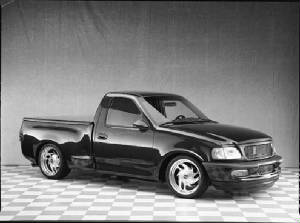
Ford F-150 pickups have been the bestselling vehicles (car
or truck) in North America for almost two decades, yet their popularity as sport trucks didn’t really take off until
1997. The redesigned 1997 trucks abandoned the twin I-beam front suspension in favor of the much easier to lower double A-arm
setup.
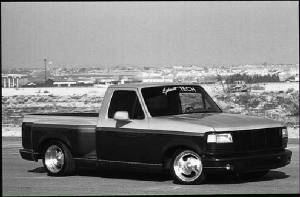
Pre-1997 F-150s are good-looking trucks, especially when
they&8217re lowered. Their front suspensions are, however, considerably more difficult to lower and align than most trucks.
This 1992 Flareside F-150 was lowered 5 inches in front and 7 inches in back.
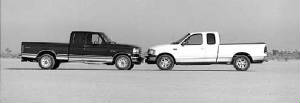
A side-by-side comparison of the 1996 F-150 on the left and
1997 on the right shows the long-lived, straight-line styling of the earlier trucks. Many truck traditionalists prefer the
earlier-style pickups.
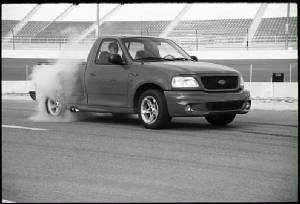
Ford brought back its factory hot rod pickup, the SVT (Special
Vehicle Team) Lightning for 1999. Its 5.4L V-8 puts out a very impressive 360 hp and 440 lb-ft of torque. The original Lightning
trucks were produced between 1992 and 1995.
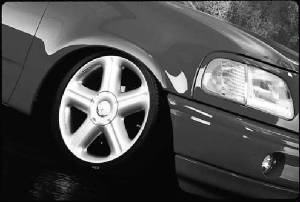
Slammed F-150s look very high-tech when fit with massive
20-inch wheels and tires. This sharp, red 1997 model was dropped an awesome 8 inches. Extensive chassis modifications and
airbags were used to achieve the drop. The MOMO wheels are 20x8 in front and 20x10 out back. The Pirelli P Zero tires are
size P255/30ZR20 and P285/30ZR20.
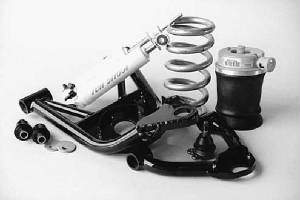
Lowering Fords became as easy as slamming Chevys when the
front suspension was changed to a double A-arm setup in 1997. Here are the necessary parts for one side of a 6-inch front
drop. Modified A-arms give 3 inches of drop, and shorter springs provide another 3 inches.
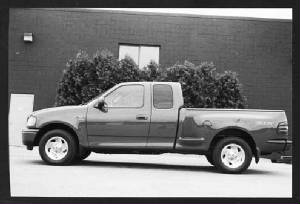
These Before and After shots illustrate a conservative 3/4
drop on a 1998 F-150 XLT Supercab Flareside. The tires are 275/60R17 Goodyear Eagles. The drop was accomplished with lowering
coil springs in front and lowering hangers and shackles in the rear.
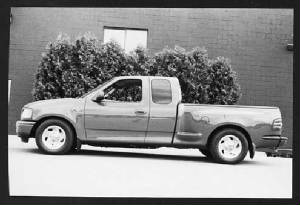
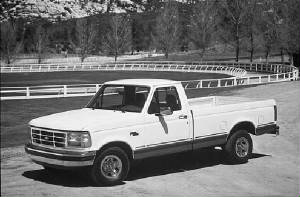
Longbed 1990-1997 Ford F-150s are extremely plentiful. They
make excellent all-around trucks, but very few people modify longbeds. Four-wheel-drive models are more popular as longbeds
than shortbeds.
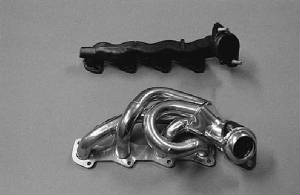
A free-flowing exhaust system is probably the best performance
improvement you can make to a V-8-powered F-150. Headers can provide increased horsepower and torque. The stock cast-iron
manifolds (top) are restrictive. The shorty headers (bottom) look a little twisted, but they do a superior job of scavenging
exhaust gases.
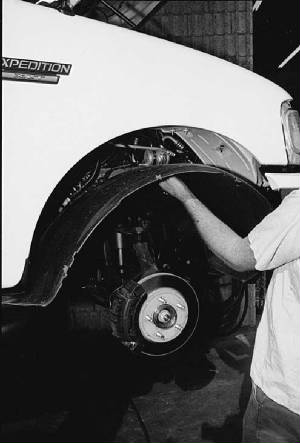
Installing headers can be a squeeze. The 1997-and-newer trucks
equipped with the 4.6L or 5.4L V-8 need to have the inner fenderwell removed for access.
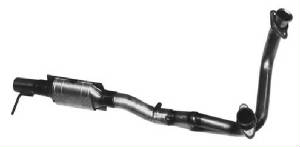
Headers are considered the cat-forward part of the exhaust
system. The rest of the system is called after-cat, although high-flow catalytic converters like this one from BBK Performance
can be installed. This Y-pipe removes the blockage caused by the factory crossover pipe.

Many people switch from the truck-style upper and lower intake
manifolds to the higher-performance Mustang units, but you can also install larger throttle bodies like these 56mm units.
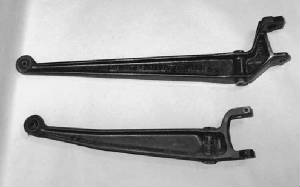
To lower pre-1997 trucks more than 2 inches, you have to
replace the stock I-beam axles (bottom) with aftermarket dropped I-beams (top). Typically, dropped I-beams will lower the
front of an F-150 3 inches. Note how the dropped I-beam moves the spindle higher. That difference from the stock one accounts
for the amount of drop.
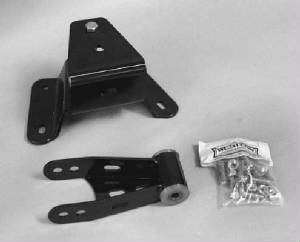
Lowering the rear suspension on F-150s is pretty easy. For
drops up to about 4 inches, most people used lowering spring hangers (top) and lowering shackles (bottom). Greater drops require
a flip kit and a frame notch.
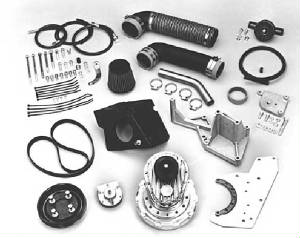
Ford offers lots of great performance equipment through its
SVO division. A SVO supercharger kit for 5.0L and 5.8L trucks can boost horsepower by 35 percent.
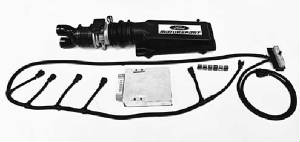
SVO offers an EFI mass-air conversion kit to convert the
stock speed-density EFI system to a mass-air system. The system is designed for 1987-1985 F-150s equipped with the 5.0L V-8.
The swap is needed to change camshafts or install performance cylinder heads.
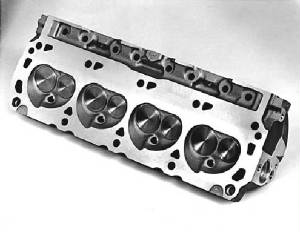
Another trick 5.0L part is aluminum cylinder heads. A couple
companies, one of which is SVO, make them. These SVO heads are 25 pounds lighter than the cast-iron stockers. Such a head
swap can be good for as much as 40 additional horses.
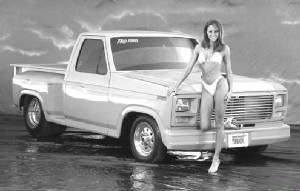
Some of the best F-series deals are on older trucks like
this 1980 Flareside. That was the first year of a major upgrade. The interiors are quite spacious, even for regular cab models.
This truck was given the Pro Street look with tubs, 15x14 wheels, and 33x19.5 Mickey Thompson Sportsman tires.
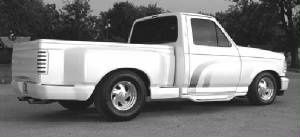
F-150s look great with new, high-tech 17-20 inch wheels,
but they can also look fantastic with 15-inchers. This 1993 Flareside runs 15x7 and 15x10 Weld wheels wrapped with 225/70R15
(front) and 285/70R15 (rear) BFGoodrich Radial T/A tires. The tall aspect ratio tires fill the wheelwell nicely, thanks to
a 5/7 drop. Dropped I-beams and shorter coil springs were used in front, and a flip kit was used in back.
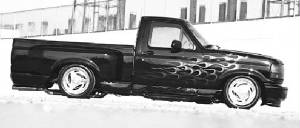
In 1992, there was a mild facelift to the F-150. The Flareside
box was brought back after a four-year hiatus. This flamed black beauty uses dropped I-beams and airbags in front and a flip
kit, a C-notch, and airbags in the rear. The wheels are 17x8 and 17x9.5 on P255/40ZR17 and P275/40ZR17 tires.
|

